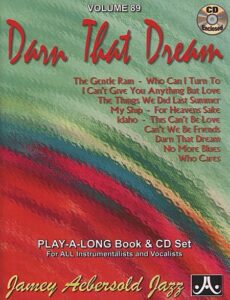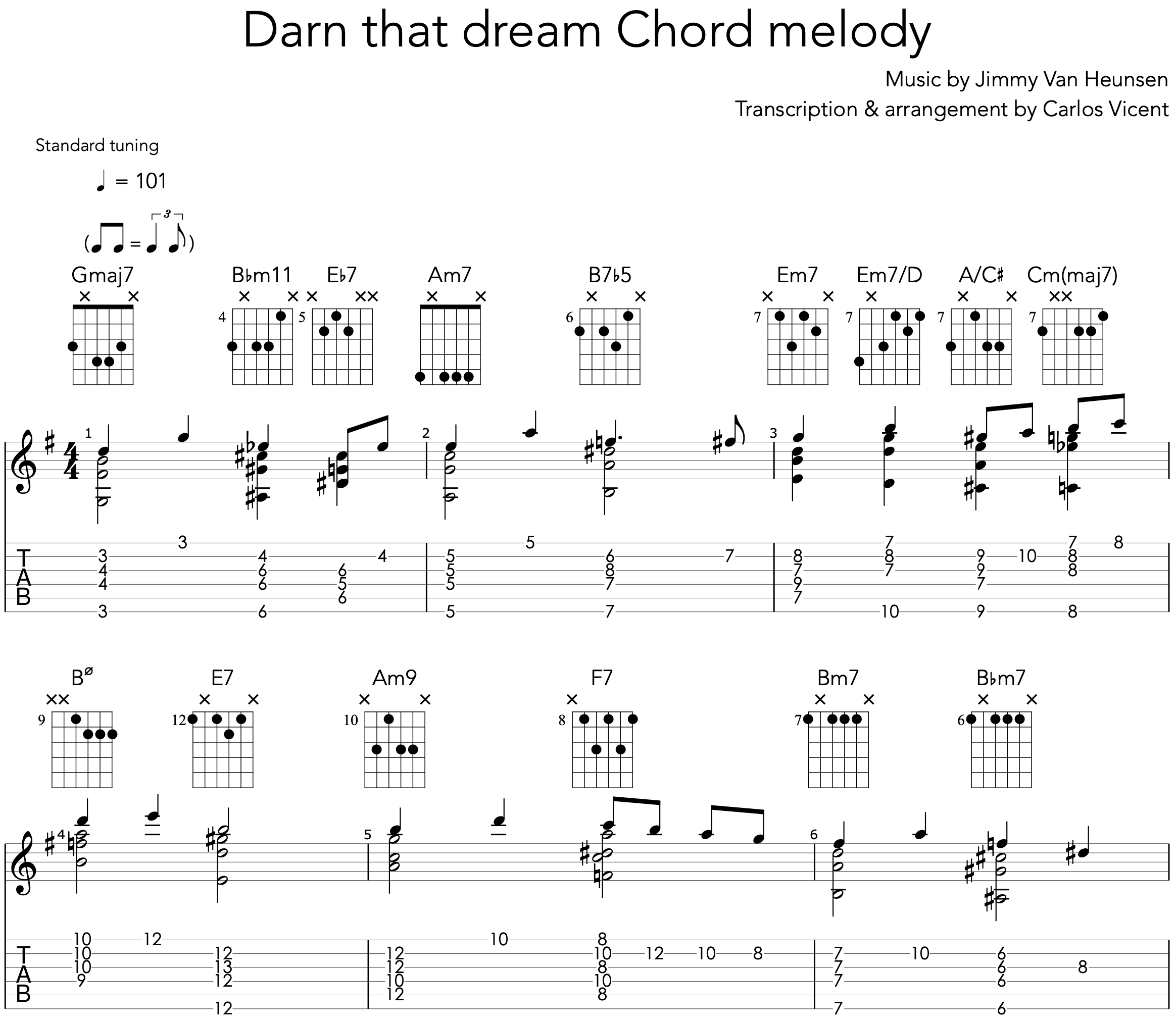Browse in the Library:
Darn that Dream – Jazz Play Along sheet music (Aebersold Vol. 89)

Darn that dream – Guitar chords and TABS sheet music
Darn that dream (Piano sheet music) – Jimmy Van Heusen
Darn That Dream (Jazz Standard)
Darn That Dream is a 1939 song, that became a universal Jazz Standard, with music by Jimmy Van Heusen and lyrics by Eddie DeLange.
This is an important ballad and is called often on the bandstand and at jam sessions.
Among those who sang “Darn That Dream” in the production were Louis Armstrong (as Bottom, pictured above), Maxine Sullivan (as Tatiana, Queen of the Pixies), Bill Bailey, Dorothy Dandridge, Vivian Dandridge, and Etta Jones, the latter three billing themselves as the Dandridge Sisters.
History
The song was first introduced by Benny Goodman and his orchestra in the Broadway musical Swingin ‘the Dream, an adaptation of William Shakespeare’s play A Midsummer Night’s Dream, which opened November 29, 1939, at the Center Theater.
The musical had disappointing results, so much so that it closed after only 13 reruns with a loss of $ 100,000. The cast of performers included, among others: Louis Armstrong in the role of Bottom; Maxine Sullivan as Titania; Butterfly McQueen as Puck; the Dandrige Sisters as you do; Benny Goodman’s orchestra and his sextet (including Lionel Hampton and Fletcher Henderson). Agnes De Mille and Walt Disney also participated in the creation of the show.
Despite the negative criticism of the work, the song was recorded before the close of the show by both Benny Goodman and Tommy Dorsey, with good results for both bands. Goodman’s recording of Mildred Bailey’s voice reached the top of the charts. At the time Jimmy Van Heusen was a fledgling composer who had been working as a pianist for Tin Pan Alley for a year.
After a brief period of poor circulation in the 1940s, the song was relaunched by Miles Davis on his album Birth of the Cool and has since established itself as the standard of the jazz repertoire.
Musical Analysis
It is a very interesting harmony theme, with numerous examples of secondary dominants, relative minor seconds, tritone substitutes, modal interchange and modulation.
For Darn That Dream, Jimmy Van Heusen uses the standard AABA form. Within this constraint, however, he takes the opportunity to create a complex melody with an abrupt change of key in the bridge, which passes from G major to Eb major.
Eddie DeLange adapts a melancholy text to the musical metrics, in which he curses the dream of an affectionate lover but never comes true. DeLange begins all four sections with the word ‘darn’ followed by ‘that dream’, ‘your lips’,’ that one-track mind of mine ‘(‘ that one way thought of mine ‘) and finally’ that dream ‘.’ DeLange ends each verse A with the line ‘oh, darn that dream’, fittingly closing those verses with the song title.
At the end of the bridge, DeLange clarifies the whole situation by saying ‘just to change the mood I’m in, I’d welcome a nice old nightmare’ old nightmare ‘). The reference to the change of mood, with the passage from frustration to ironic humor, coincides with the change of key of the music.
When learning standards (or any music that was released on record in the first place), the starting point should always be by ear. So, hearing different versions of the same song not only allows you to internalize the melody, harmony and rhythm, but also to appreciate the approach of each artist and type of instrumental ensemble that has recorded it.
A simple, but efficient chord melody structure could be like this:

Other performances:
Blue Barron e la sua orchestra (voce: Russ Carlyle) (1940)
Tommy Dorsey e la sua orchestra (voce: Anita Boyer) (1940)
Miles Davis - Birth of the Cool (voce: Kenny Hagood) (1950)
Chet Baker e Stan Getz - West Coast Live (1954)
Clifford Brown e Max Roach - Brown and Roach Incorporated (1954)
Gerry Mulligan e Chet Baker - Gerry Mulligan Quartet Featuring Chet Baker (7" EP, 1954)
Dinah Washington - Dinah Jams (1954)
Tony Bennett - Cloud 7 (1955)
Doris Day - Day Dreams (1955)
Dexter Gordon - Daddy Plays the Horn (1955), One Flight Up with Chet Baker (1964)
Ahmad Jamal - Chamber of the New Jazz (1955)
Thelonious Monk - The Unique Thelonious Monk (1956)
Billie Holiday - Body and Soul (1957)
Chet Baker - Chet Baker Big Band (1958)
Art Farmer - Modern Art (1958)
Sarah Vaughan with Count Basie Orchestra - No Count Sarah (1958)
Petula Clark - Petula Clark in Hollywood (1959)
Bill Evans and Jim Hall - Undercurrent (1962)
Ella Fitzgerald and Nelson Riddle - Ella Swings Gently with Nelson (1962)
Nancy Wilson - But Beautiful (1969)
Martial Solal - En solo (1971)
Cedar Walton, Clifford Jordan - The Pentagon (1976)
Petrucciani Trio - Darn That Dream (1982)
Andrew Hill - Verona Rag (1987)
Thelonious Monk - colonna sonora del film Alice (1990), di Woody Allen[4]
Tom Harrell - Labyrinth (1996)
Quintorigo - In cattività (2003)
Dianne Reeves - A Little Moonlight (2003)
Clifford Brown & Max Roach- colonna sonora del film Criminal (2004), di Gregory Jacobs[5]
Royce Campbell - Six by Six: A Jazz Guitar Celebration (2005)
Vijay Iyer - Solo (2010)
Pearl Django - Système D (2010)